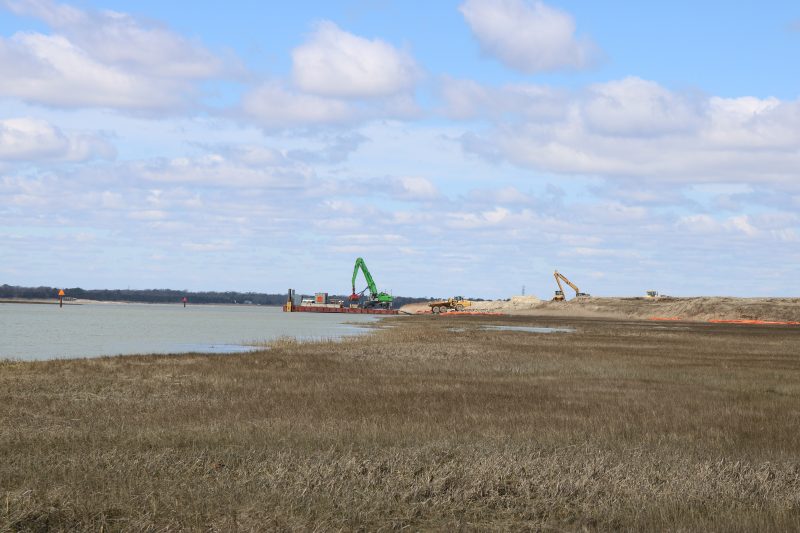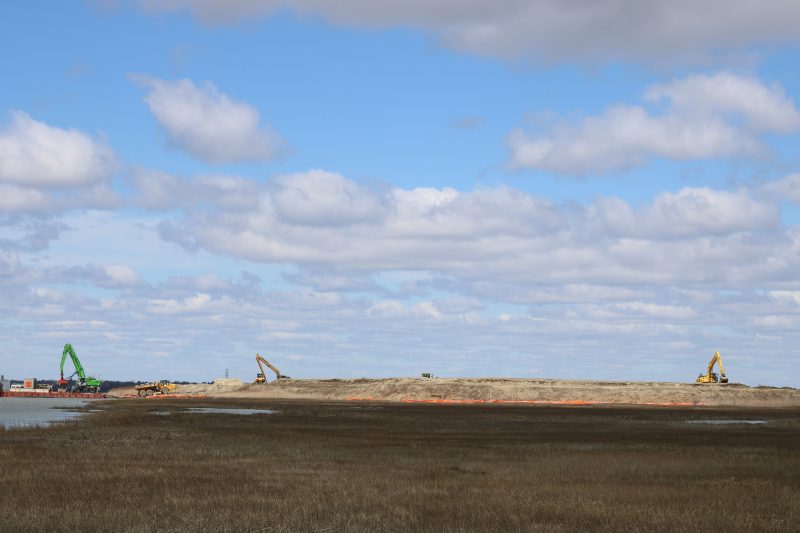 By DONALD WITTKOWSKI
Rising out of the marshlands surrounding Ludlam Bay off Sea Isle City is a huge mound of earth that appears large enough to be an island.
The locals refer to it as “Dredge Island.”
The New Jersey Department of Transportation has given it a more ominous sounding name, the Ludlam Confined Disposal Facility, or CDF.
There was little or no activity on this obscure manmade patch of terra firma in recent years, but suddenly it has come alive with large excavators, bulldozers and other heavy construction equipment crawling all over it.
Social media has been abuzz with rumors about what is going on. One Facebook poster humorously suggested that it involves the never-ending nationwide search for Jimmy Hoffa’s body after the Teamsters union leader was allegedly murdered by the mob in the 1970s.
But a call to the Department of Transportation has brought the real reason why so much construction machinery is out digging on the site. Sorry, folks, it doesn’t involve anything as intriguing as the search for Hoffa’s body.
The site was damaged during Hurricane Sandy in 2012 and now the DOT is repairing it to have it ready to accept sediment from future dredging projects at the Jersey Shore, agency spokesman Steve Schapiro said.
By DONALD WITTKOWSKI
Rising out of the marshlands surrounding Ludlam Bay off Sea Isle City is a huge mound of earth that appears large enough to be an island.
The locals refer to it as “Dredge Island.”
The New Jersey Department of Transportation has given it a more ominous sounding name, the Ludlam Confined Disposal Facility, or CDF.
There was little or no activity on this obscure manmade patch of terra firma in recent years, but suddenly it has come alive with large excavators, bulldozers and other heavy construction equipment crawling all over it.
Social media has been abuzz with rumors about what is going on. One Facebook poster humorously suggested that it involves the never-ending nationwide search for Jimmy Hoffa’s body after the Teamsters union leader was allegedly murdered by the mob in the 1970s.
But a call to the Department of Transportation has brought the real reason why so much construction machinery is out digging on the site. Sorry, folks, it doesn’t involve anything as intriguing as the search for Hoffa’s body.
The site was damaged during Hurricane Sandy in 2012 and now the DOT is repairing it to have it ready to accept sediment from future dredging projects at the Jersey Shore, agency spokesman Steve Schapiro said.

The big mound of earth in the marshlands was created by piles of dredge material scooped out of Jersey Shore waterways over the years.
The Ludlam CDF has existed for decades and primarily has been used as a disposal site by the U.S. Army Corps of Engineers for dredging the Intracoastal Waterway, according to Schapiro.
The DOT is working with the Army Corps of Engineers to determine future dredging needs and a schedule for doing the work.
“At this time NJDOT has no dredging projects planned in the immediate area,” Schapiro said in an email Wednesday.
In the meantime, repairs are underway at the Ludlam site that will take three or four months to complete.
In Hurricane Sandy’s aftermath, the DOT announced a comprehensive State Channel Dredging and Emergency Response Program in March 2014 to ensure and maintain safe navigation statewide, and to continue to be able to respond adequately to waterway impacts from named storms, such as the powerful nor’easter Jonas in January 2016, Schapiro said.
“Since the program’s inception we have dredged more than 1 million cubic yards of sediment from more than 50 critically shoaled channels statewide, restoring these channels to a safe navigable depth,” he said in the email. “Sediment has either been placed in confined disposal facilities (CDFs) or used in a variety of beneficial ways such as beach replenishment, dune creation, marsh enhancement, landfill cover and to restore subaqueous borrow pits.”
The Ludlam site is part of that program. However, its history as a disposal site for dredge projects dates back much further. Over the years, all of the dredge material piled on top of the site created the distinctive mound in the marshlands known to locals as Dredge Island.
 By DONALD WITTKOWSKI
Rising out of the marshlands surrounding Ludlam Bay off Sea Isle City is a huge mound of earth that appears large enough to be an island.
The locals refer to it as “Dredge Island.”
The New Jersey Department of Transportation has given it a more ominous sounding name, the Ludlam Confined Disposal Facility, or CDF.
There was little or no activity on this obscure manmade patch of terra firma in recent years, but suddenly it has come alive with large excavators, bulldozers and other heavy construction equipment crawling all over it.
Social media has been abuzz with rumors about what is going on. One Facebook poster humorously suggested that it involves the never-ending nationwide search for Jimmy Hoffa’s body after the Teamsters union leader was allegedly murdered by the mob in the 1970s.
But a call to the Department of Transportation has brought the real reason why so much construction machinery is out digging on the site. Sorry, folks, it doesn’t involve anything as intriguing as the search for Hoffa’s body.
By DONALD WITTKOWSKI
Rising out of the marshlands surrounding Ludlam Bay off Sea Isle City is a huge mound of earth that appears large enough to be an island.
The locals refer to it as “Dredge Island.”
The New Jersey Department of Transportation has given it a more ominous sounding name, the Ludlam Confined Disposal Facility, or CDF.
There was little or no activity on this obscure manmade patch of terra firma in recent years, but suddenly it has come alive with large excavators, bulldozers and other heavy construction equipment crawling all over it.
Social media has been abuzz with rumors about what is going on. One Facebook poster humorously suggested that it involves the never-ending nationwide search for Jimmy Hoffa’s body after the Teamsters union leader was allegedly murdered by the mob in the 1970s.
But a call to the Department of Transportation has brought the real reason why so much construction machinery is out digging on the site. Sorry, folks, it doesn’t involve anything as intriguing as the search for Hoffa’s body.
 The big mound of earth in the marshlands was created by piles of dredge material scooped out of Jersey Shore waterways over the years.
The Ludlam CDF has existed for decades and primarily has been used as a disposal site by the U.S. Army Corps of Engineers for dredging the Intracoastal Waterway, according to Schapiro.
The DOT is working with the Army Corps of Engineers to determine future dredging needs and a schedule for doing the work.
“At this time NJDOT has no dredging projects planned in the immediate area,” Schapiro said in an email Wednesday.
In the meantime, repairs are underway at the Ludlam site that will take three or four months to complete.
In Hurricane Sandy’s aftermath, the DOT announced a comprehensive State Channel Dredging and Emergency Response Program in March 2014 to ensure and maintain safe navigation statewide, and to continue to be able to respond adequately to waterway impacts from named storms, such as the powerful nor’easter Jonas in January 2016, Schapiro said.
“Since the program’s inception we have dredged more than 1 million cubic yards of sediment from more than 50 critically shoaled channels statewide, restoring these channels to a safe navigable depth,” he said in the email. “Sediment has either been placed in confined disposal facilities (CDFs) or used in a variety of beneficial ways such as beach replenishment, dune creation, marsh enhancement, landfill cover and to restore subaqueous borrow pits.”
The Ludlam site is part of that program. However, its history as a disposal site for dredge projects dates back much further. Over the years, all of the dredge material piled on top of the site created the distinctive mound in the marshlands known to locals as Dredge Island.
The big mound of earth in the marshlands was created by piles of dredge material scooped out of Jersey Shore waterways over the years.
The Ludlam CDF has existed for decades and primarily has been used as a disposal site by the U.S. Army Corps of Engineers for dredging the Intracoastal Waterway, according to Schapiro.
The DOT is working with the Army Corps of Engineers to determine future dredging needs and a schedule for doing the work.
“At this time NJDOT has no dredging projects planned in the immediate area,” Schapiro said in an email Wednesday.
In the meantime, repairs are underway at the Ludlam site that will take three or four months to complete.
In Hurricane Sandy’s aftermath, the DOT announced a comprehensive State Channel Dredging and Emergency Response Program in March 2014 to ensure and maintain safe navigation statewide, and to continue to be able to respond adequately to waterway impacts from named storms, such as the powerful nor’easter Jonas in January 2016, Schapiro said.
“Since the program’s inception we have dredged more than 1 million cubic yards of sediment from more than 50 critically shoaled channels statewide, restoring these channels to a safe navigable depth,” he said in the email. “Sediment has either been placed in confined disposal facilities (CDFs) or used in a variety of beneficial ways such as beach replenishment, dune creation, marsh enhancement, landfill cover and to restore subaqueous borrow pits.”
The Ludlam site is part of that program. However, its history as a disposal site for dredge projects dates back much further. Over the years, all of the dredge material piled on top of the site created the distinctive mound in the marshlands known to locals as Dredge Island.